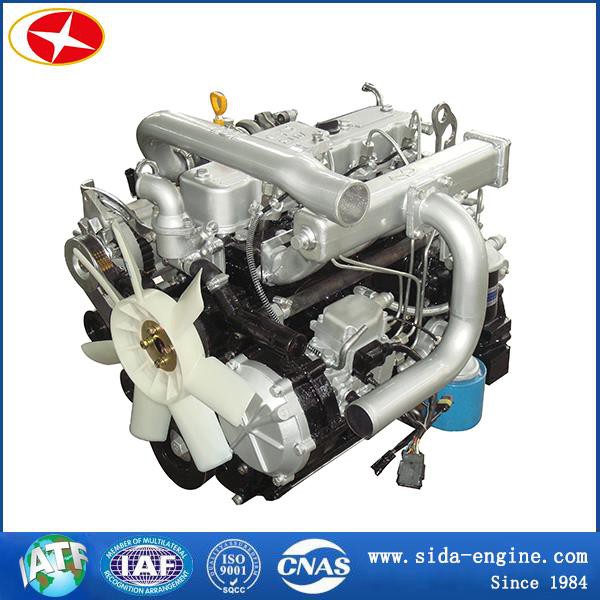Hey there! As a supplier of Rice Harvester Engines, I often get asked about the different parts of these engines. One component that doesn't always get the spotlight but is super important is the rocker arm. So, let's dig into what the rocker arm is in a rice harvester engine.


What the Heck is a Rocker Arm?
In simple terms, a rocker arm is like a little seesaw inside your rice harvester engine. It's a pivoting lever that transfers motion from the camshaft to the valves. The camshaft has these lobes on it that stick out at different points. As the camshaft rotates, these lobes push against one end of the rocker arm.
When the lobe pushes up on the rocker arm, the other end of the rocker arm pushes down on the valve stem. This action opens the valve, allowing either the fuel - air mixture to enter the combustion chamber or the exhaust gases to exit. Once the lobe passes, the valve spring pulls the valve back up, closing it.
Why is the Rocker Arm So Important?
Now, you might be thinking, "It's just a little lever. How important can it be?" Well, it's actually crucial for the engine's performance.
Firstly, it's all about timing. The rocker arm ensures that the valves open and close at just the right time. In a rice harvester engine, precise timing is key. If the valves open too early or too late, the engine won't run efficiently. The fuel - air mixture might not burn properly, which can lead to reduced power, poor fuel economy, and even engine damage over time.
Secondly, the rocker arm helps in controlling the valve lift. The amount the valve opens (valve lift) affects how much air and fuel can enter the combustion chamber or how quickly the exhaust can leave. In a rice harvester, where the engine needs to perform under different loads, having the right valve lift is essential for optimal power output.
Types of Rocker Arms in Rice Harvester Engines
There are a few different types of rocker arms used in rice harvester engines.
1. Roller Rocker Arms
Roller rocker arms have a roller at the end that contacts the camshaft lobe. This design reduces friction compared to a traditional flat - faced rocker arm. With less friction, there's less wear and tear on both the rocker arm and the camshaft. It also allows for more precise movement, which can improve the engine's performance, especially at higher speeds.
2. Stamped Rocker Arms
These are the most common type. They're made by stamping a piece of metal into the shape of a rocker arm. Stamped rocker arms are relatively inexpensive to produce, which makes them a popular choice for many rice harvester engines. They're durable enough for normal operating conditions but might not offer the same level of performance as roller rocker arms.
Maintenance of Rocker Arms
Taking care of the rocker arms in your rice harvester engine is important for its longevity.
Regular inspection is a must. You should check for any signs of wear, such as excessive play or pitting on the contact surfaces. If you notice any unusual noise coming from the engine, like a tapping or clicking sound, it could be a sign that the rocker arm is worn or loose.
Lubrication is also crucial. The rocker arms need a good supply of clean oil to reduce friction and prevent wear. In a rice harvester, the engine is often working in dusty and dirty conditions, so the oil can get contaminated quickly. Make sure to change the oil at the recommended intervals and use the right type of oil for your engine.
How Rocker Arms Fit into the Big Picture
The rocker arm is just one part of a complex system in a rice harvester engine. It works in harmony with other components like the camshaft, valves, valve springs, and pistons.
For example, the camshaft is driven by the crankshaft through a timing belt or chain. As the crankshaft rotates, it powers the camshaft, which in turn activates the rocker arms. The pistons move up and down in the cylinders, creating the compression and expansion cycles that are essential for the engine to run. And the valves, controlled by the rocker arms, manage the flow of air, fuel, and exhaust.
Other Engines in Agricultural Machinery
While we're on the topic of agricultural engines, it's worth mentioning that similar rocker arm systems are used in other types of engines too. For instance, Threshe Engines and Soybean Harvester Engines also rely on rocker arms for proper valve operation.
These engines might have some differences in size, power output, and specific design, but the basic principle of the rocker arm remains the same. In each case, the rocker arm plays a vital role in ensuring that the engine runs smoothly and efficiently.
Wrapping Up and Reaching Out
So, there you have it! The rocker arm might seem like a small part, but it's a big deal in a rice harvester engine. It's all about timing, valve lift, and keeping the engine running smoothly.
If you're in the market for a new rice harvester engine or need replacement parts for your existing one, we're here to help. Our Rice Harvester Engines are built to high - quality standards, with all components, including the rocker arms, carefully designed and tested.
Whether you have questions about rocker arms, engine performance, or need advice on which engine is right for your rice harvesting needs, don't hesitate to reach out. We're always happy to have a chat and help you make the best decision for your agricultural operations.
References
- Automotive Engine Design textbooks
- Manufacturer's manuals for rice harvester engines






